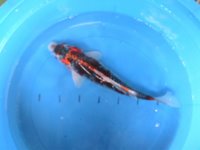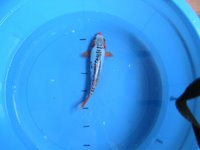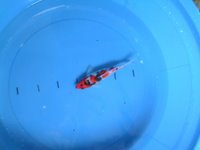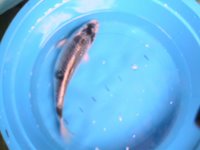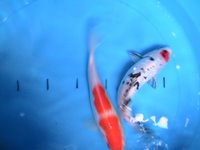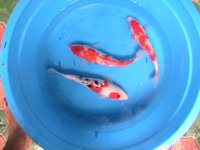By Brett Fogle
Now that Spring is upon us and things are coming back to life in your pond with the warmer weather, many of us are battling with string algae. String algae is caused primarily by a combination of the buildup of organic nutrients in the water, and sunlight.
What happens is that during winter, when things slow down and many of us turn off our filters, decaying leaves and other organic matter (including fish waste) begin to break down in the pond.
The result is an excess of organic nutrients in the water, which is essentially food for algae growth. Add sunlight and some warmer weather to these conditions, and you have an ideal environment for algae growth, both the green water and string algae varieties.
The green water, or 'pea soup' algae is easily eradicated with a properly sized UV sterilizer, which we highly recommend. String algae, on the other hand, is a bit more complicated and difficult to get rid of.
Because it is usually attached to the walls and rocks of the pond, it becomes more difficult to get rid of and unfortunately, there aren't and easy solutions. But we are going to outline a few remedies here that will help. First, we recommend a pond cleaning - if possible. For those of you who don't clean your pond at least once annually, there are many good reasons to do this.
By cleaning out your pond, and removing as much of the decaying organic material from the bottom, you are also removing much of the 'food' for the algae.
Another good thing to do is to cut back on feeding your fish, until you get your string algae under control. The fish food, both eaten and digested, and the uneaten food, will both also contribute to this algae growth - so don't worry about the fish, just stop feeding for awhile.
There are several products available which can and will 'help' with the string algae problem, like barley bales and/or barley pellets. The idea is that by adding these to the pond, they will also start to decay in the water, and the resulting natural 'humic acids' will actually oxidize the algae, and help keep it under control.
Farmers in the 13th century noticed that lakes with bales of barley straw in them, had much less muck and string algae in them. So, now we use them in fish ponds. Barley pellets are a newer version of the same idea, but will generally start working faster. Barley straw needs several weeks before it starts working, and only after it starts to 'rot' in the water.
Another way to help with string algae is to raise your salt level in the pond. Anything over .3% will help control the algae, but is best for KOI ponds, as the salt may also negatively affect water garden plants.
We also really like the Microbe Lift line of products. They also seem to help control string algae, by adding millions of beneficial microbes and beneficial bacteria that will feed off of this algae and also help to decompose any other organic waste in the pond.
An alternate method that many pond owner prefer is to add a chemical algaecide like PondCare's Algae Fix. This is safe for fish and plants, and does seem to temporarily knock out suspended and filamenous algae, but does need to be added periodically for long term control.
One new method that we've been hearing more and more about is adding a certain type of clay to the pond water. Calcium Montmorillonite Clay is gaining popularity among KOI pond owners and water gardeners as an effective, natural method of algae control. It is also noted as having many beneficial qualities for the fish in the pond.
Hope this helps!
Happy pondkeeping.
Publishing Guidelines: You have permission to publish this article electronically or in print, free of charge, as long as the bylines are included. A courtesy copy of your publication would be appreciated.
About The Author
Brett Fogle is the owner of MacArthur Water Gardens and several pond-related websites including macarthurwatergardens.com and pond-filters-online.com. He also publishes a free monthly newsletter called PondStuff! with a reader circulation of over 6,000 pond owners. To sign up for the free newsletter and receive a complimentary 'New Pond Owners Guide' for joining, just visit MacArthur Water Gardens>
Article Source: http://EzineArticles.com/?expert=Brett_Fogle
Thursday, September 28, 2006
The String Algae Blues
Posted by ars at 4:21 PM
Summer Pond Tips
By Brett Fogle
Low Oxygen levels Kill Fish
Use an oxygen tester and air stones to keep your available
oxygen level to at least 7.0 parts per million of dissolved
oxygen in 90 degree F. water. Koi and goldfish start showing
signs of stress at oxygen levels of 4.0 ppm and will start
dying at 3.0 ppm. The higher the water temperature goes the
less oxygen that's available. Water temperatures over 90
degrees will also affect fish health so keep the temperature
under control by providing shade during the hottest parts of
the day.
It's Parasite Season
Warm water causes an increase in parasites such as anchor
worms, fish lice or flukes. Some parasites such as anchor worm
and fish lice are visible and can be treated with Dylox,
Dipterex or Masoten.
Invisible parasites such as external protozoa and flukes can
not be seen but they usually cause symptoms including extra
thick mucus, constant scratching by rubbing against objects,
flashing, or jumping. Some variations will cause a noticeable
head shaking and yawning. COntact your pond specialist for
treatments because different symptoms are indicative of
different infections. Follow label instructions at all times
or you could cause serious injury or death to your fish.
Summer Koi Feeding Tips
If you water is between 70 to 85 F. then feed a low protein
food in a quantity that is equal to 1.0% to 1.5% of total koi
body weight in pond. Estimate total koi body weight in pond
and feed recommended % of food daily based on season and water
temperature divided into intervals of about 2-2-1/2 hours.
Takes koi about 2- 2-1/2 to digest food in warmer water and
4-8 hrs in colder water when feeding is begun. So in warmer
ideal water temperatures feed 5-8 times daily the individual
portions totaling daily amount needed. In cooler temperatures
feed 1-3 times daily.
Sunblock for your Koi
Koi are not immune from sunburn, especially in shallow ponds
that get direct sunlight. Provide shade such as water lilies
or a rock overhang. Even a beach umbrella will do in a pinch.
Watch for Evaporation
Depending upon the surface area of your pond, you can lose
several inches per day to evaporation. Monitor and adjust your
water levels daily or as neccessary. Remember, do not use
water with chlorine in it if you have fish!
Five Quick Tips For Healthy Summertime Water
1. Ensure that you have good mechanical and biological
filtration and that your pump will turn the pond water over
totally at least twice per day.
2. Operate the pump 24 hours a day.
3. Provide adequate shade by having 60 to 70% of the pond's
surface area covered with floating plants or other types of
shade.
4. Add water clarifiers and bottled bacteria if your water
remains cloudy even when good filtration is present.
5. Test oxygen levels daily and add air stones if levels fall
below 7 PPM.
************************************************
Brett Fogle is the owner of MacArthur Water Gardens and several
pond-related websites including macarthurwatergardens.com and
pond-filters-online.com. He also publishes a free monthly
newsletter called PondStuff! with a reader circulation of over
9,000 pond owners. To sign up for the free newsletter and
receive a complimentary 'New Pond Owners Guide' for joining,
just visit MacArthur Water Gardens by clicking the link above.
>
************************************************
Article Source: http://EzineArticles.com/?expert=Brett_Fogle
Posted by ars at 4:14 PM
Sunday, September 24, 2006
Pond Construction
By Robert Dorrance
The location of your pond should be decided. You’ve picked a good spot in your yard where you can see the pond from different places, and it’s near enough to the house so you can see it from a window. This is really part of the fun because you can visualize the landscaping ideas you’ll be incorporating into the pond area once the dig is finished.
The first thing to do is outline the perimeter of your pond. Avoid square or sharp corners because your pond liner will conform much better to a freeform round or kidney shape. You should also have made the decision by this time about the size of the design. I would strongly suggest not going too small. I changed the size of our pond two times because the first and second time just weren’t big enough. Lay out the final design and size on the ground where you plan to dig with a can of spray paint.
The next thing to decide is the depth of the pond. I would suggest at least twenty four to thirty six inches. Our pond is thirty six to forty eight inches deep and the main reason is the fact that we have fish. Some of our fish are quite large, we have two Koi’s that are about eighteen inches long and they definitely need the room. If you’re going to have fish, or think you might get fish in the future, then don’t skimp on pond depth. If you live in a cold winter climate like we do, then the fish need room at the bottom to winter over. Like I mentioned previously, we haven’t lost a fish to the winter in the eight years we’ve had our pond.
Keep in mind that you want to keep the top ‘shoreline” edges pretty level. The reason for this is that once you put the liner in and fill the pond with water you won’t have a large piece of the liner showing on the high side of the hole. Also as you dig, remember that you are going to want a ledge most of the way around the perimeter of the hole, about six to twelve inches down from the top and about twelve inches wide. This will provide you with a “shelf” to set your pond plants on.
Once the hole is dug and shaped to your satisfaction and with any protruding sharp rocks removed to provide a relatively smooth surface for the liner to rest on, then you are ready to install the liner. Here are the quick calculations to figure the size of your liner:
Length: Length of the dug out area plus two feet plus the depth plus three feet.
Width: Width of the dug out area plus two feet plus the depth plus three feet.
For Example: The hole is ten feet long by six feet wide and the depth is three feet. Therefore, the liner LENGTH is 10 + 2 +3 +3 = 18 feet. And the WIDTH is 6 + 2 +3 + 3 = 14 feet. So the needed liner size is 18 feet long and 14 feet wide.
Some people have lined the dug hole with old carpet scraps to provide a little extra cushion under the liner and also a little more protection in case a sharp rock may have escaped detection. Personally, I didn’t do this and we haven’t had any leakage problems.
So, now it’s time to install the liner. Make it easier and get some help for this operation. Position the liner over the hole, trying to keep an even overlap on all four sides. Next push the liner down into the hole as evenly as you can, keeping in mind that you want the overlap to be as equal as possible all the way around the hole. When you are satisfied that the liner is positioned correctly, place a few heavy rocks on the overlap equally spaced around the pond.
Now it’s time to start filling the pond. Obviously, the smaller the pond, the quicker the fill. A large pond can take quite a while, and while it is filling use the time to disperse the liner evenly so that you don’t get a lot of large folds. You’re bound to get some folds but if you work on smoothing them out as the water is going in the end result will be a nicer appearance. If you have to make any moves to even out the overlap, do it before too much water is added because it gets heavy fairly quickly and once the weight of the water takes over you won’t be moving anything. As the pond fills and the liner conforms to the shape of the hole and you see that your overlap around the edges is looking pretty good, then you can start to relax because the hard part is done.
Robert Dorrance has had a pond for the last eight years and would like to share his experiences with you. You can read other articles and download my free e-book, “How To Build A Beautiful Backyard Pond at http://www.Backyard-Pond-Guide.com
Article Source: http://EzineArticles.com/?expert=Robert_Dorrance
Posted by ars at 9:53 AM
Thursday, September 07, 2006
Fish Health in Hot Summer Heat
By Brett Fogle
Summer is over, but for many of us - the heat remains.Here a couple of things to do to keep your fish healthyand your pond clear going into winter. First, rememberto keep your pond well aerated. This is very importantto your fish because the pond water actually holds lessoxygen at higher pond temperatures. So if it's stillhot in your part of the country, keep those waterfallsand fountains running! This will keep your pond waterfull of oxygen, and reduce stress on your fish.
If you see your goldfish or KOI gasping at the surface,it's a good sign that you don't have enough dissolvedoxygen in the water, and this can be dangerous.Especially if you have a lot of green water algae inthe pond. This algae can absorb much of the oxygen inthe pond water at night and cause very low dissolvedoxygen levels during the day - which can be deadly tofish!
One thing we recommend this time of year, is to do apartial water change. Drain off 10 - 25% of your totalpond volume, and replace it with fresh, newdechlorinated water. If possible, vacuum or draindecaying organic matter and debris off the bottom toreduce the ponds bio-load.
Your fish will usually be vibrant and playful after awater change. It's like giving them a 'breath of freshair' and invigorates them. Again, we only recommend a10 - 25% water change right now - but feel free toexperiment with whatever works best for your pond.
Remember to re-add your pond salt whenever you drainand add new water. Having a salt water test kit is alsohelpful, or a digital salinity meter, to determineoptimum salt levels.
**************************************************
Brett Fogle is the owner of MacArthur Water Gardens and several
other pond-related websites includingMacArthurWatergardens.com
and Pond-Filters-Online.com. He also publishes a free monthly
newsletter called PondStuff! with a reader circulation of over
9,000. To sign up for the free newsletter and receive our FREE
'New Pond Owners Guide' visit MacArthur Water Gardens today!
**************************************************
Article Source: http://EzineArticles.com/?expert=Brett_Fogle
Posted by ars at 9:17 PM
Wednesday, September 06, 2006
Overwintering Pond Fish
By Brett Fogle
The metabolism of koi and goldfish is controlled primarily bywater temperature. As the water cools, pond fish require lessprotein in their diet. When koi and goldfish are fed high-proteinfood in cool water, the excess protein is excreted as ammoniafrom the gills. The microscopic organisms that make up thebiological filter (and consume ammonia) also slow down in coolerwater.
Improper seasonal feeding can lead to a build-up of toxicammonia, which stresses fish and reduces their wintersurvivability. When the water temperature drops to approximately65° F, start feeding with Spring & Autumn Pond Food. This type offish food is better suited for the dietary requirements of pondfish in cool water and won’t pollute the water with excessammonia. Some water gardeners continue to feed their fish untilthey no longer come to the surface. I stop feeding my pond fishwhen the water falls below 42° F.
There is no need to worry about "frozen fish" if a section of thepond is at least 18 inches deep. Pond fish will seek the deepestpart of the pond and over-winter there until the water warms inthe spring. If your pond is less than 18 inches deep, the fishmay freeze during a harsh winter. Check with your local pondsupplier if you live in an area with harsh winters.
Some water gardeners with shallow ponds attempt to keep their koiand goldfish in kiddie pools or aquariums set up in a coolbasement or garage. This is not recommended because of the extrastress involved in netting, transporting, and re-acclimating thefish to the new environment.
However, if you dont have a choice, and need to bring your fishinside for the winter, be sure to have an aquarium air pump orsmall fountain to provide oxygenation. The fish should be fedinfrequently, if at all, depending on the water temperature. pH,ammonia and nitrite, which should be monitored weekly andespecially if the fish are fed.
Small water changes (20%) each month will keep the water in goodshape until spring. Koi are "jumpers"-so be sure to cover thepool with bird netting!
**************************************************
Brett Fogle is the owner of MacArthur Water Gardens and several
other pond-related websites includingMacArthurWatergardens.com
and Pond-Filters-Online.com. He also publishes a free monthly
newsletter called PondStuff! with a reader circulation of over
9,000. To sign up for the free newsletter and receive our FREE
'New Pond Owners Guide' visit MacArthur Water Gardens today!
**************************************************
Article Source: http://EzineArticles.com/?expert=Brett_Fogle
Posted by ars at 11:15 PM
Tuesday, September 05, 2006
Easy Ways to Build Home Ponds
By Dave Wills
Having a pond in the backyard will definitely be an eye catching sight for everyone.The sound of water, beautiful fishes and exotic plants all makes your mind cool and relaxed besides feeling fresh. So if you think you can feel fresh, relaxed and cool by making your backyard beautiful, now is the best time to start it.
Having a pond in your backyard is not a tough job. It can be easily done with some proper planning and implementation. This article deals with various techniques and strategies that you can make use of while building a backyard pond.
Finding the best suited pond
Before starting pond building the first question you have to solve is in relation to the type of pond that you want to build. Solving this question will help to find answers for where to locate the pond, what features to include, how much depth and width to keep etc.
Generally home ponds are of the following kinds
1.) Basic ponds
2.) Water gardens
3.) Koi ponds
4.) Wildlife ponds
Basic ponds
These are ponds that have been built to include basic water features. Such ponds may not have any exotic pond plants or pond life. These kinds of ponds are easy to build and the calculations involved in building is also less.
Water gardens
Water gardens are ponds having water falls, pond plants and pond life like exotic fishes. The depth of these ponds should be at least 2-3 feet with a view to keep the fishes and the water plants healthy. This kind of ponds can be located in open spaces away from deciduous trees so that the maintenance can be reduced.
Koi ponds
Koi ponds are ponds that are specially designed to keep koi. The water capacity of these ponds depends upon the number of koi fishes that you are planning to introduce It is advisable to locate koi ponds in shady area away from direct sunlight.
Wildlife ponds
These are ponds specially designed for keeping wildlife. Such ponds include frog, turtles etc apart from fishes and pond plants. The specifications for this pond are similar to that of water garden.
Techniques to be followed while building ponds
In simple words any one of the undrementioned techniques can be used to your pond. The first two techniques can be managed by yourselves while you have to opt for professional labor if you have to go for the third one.
Making use of a flexible pond liner
The use of proper pond liner is highly appreciated, especially you are a beginner. This process includes finding out a best suited spot for the pond in your backyard. Even you can make use of garden hose or clack to mark the spot and at last measurements have to be taken for buying the flexible liner. You can have the liner from any shop dealing with pond products making sure that they deal with high quality products.
If you have got a shovel, you can start digging the marked spot. The depth of the dig depends on the type of pond that you are planning to make. After that the liner has to be placed into the excavated part and the edges are to be covered with decorative stones. The next step is to fill the water by garden hose. Pond filters can be introduced with a view to keep the pond water neat and clean.
Proper use of performed garden ponds
In order to make things simpler you can make use of preformed garden ponds that are available in the market in a variety of shapes and sizes. You can get them ready made and make use of them as wished by you. If you are interested in a below ground pond, then you have to start the digging process as mentioned and lay the performed pond.In this case with a view to help it settle down well water can be introduced into the pond at the time of laying. At that time you have to make sure that no dirt is inside the pond to prevent damage.
Proper use of concrete
If you are planning to make use of concrete, it’s better to take professional help, because the process involved. After the concrete pond is ready, first fill it with water and wash it to remove all the chemicals. You have to repeat this for two weeks if you are planning to introduce exotic fishes and plants.
By properly following the above mentioned techniques it is possible to make your back yard colorful and attractive. Cool Pondscaping
About the Author
abcponds.com is a site specially dedicated to information regarding http://www.abcponds.com/ pond building. It provides valuable ideas in relation to ponding resources and design tips.
Article Source: http://EzineArticles.com/?expert=Dave_Wills
Posted by ars at 11:57 AM
Sunday, September 03, 2006
Saturday, September 02, 2006
Koi Pond Aeration
By Robert Dorrance
To achieve Koi pond aeration, there are some things you can do. One, you can go to your local hobby store or pet supply store and purchase one of those small air pumps, hook some tubing to it, along with an air diffuser or sometimes called an air stone, and place it in your pond. I still have the original one I bought about eight years ago, and it’s still working. This has run for almost eight years non-stop, they are very durable. It works two fold, one, to supply air to the pond water and, two, it helps to keep a hole open in the ice during the winter.
Another way to obtain Koi pond aeration is to have different kinds of under water pond plants such as Anacharis and Hornwort. These plants will grow and spread out very well under water. Just kind of put them in small bunches in the bottom of your pond. Just so you know if your plant them in some kind of pot, chances are very good that your Koi will pull them out. Koi are always tugging and uprooting something.
Waterfalls also provide a great way to help aerate the Koi pond. By constantly having water running down a waterfall and crashing into the pond, will help naturally aerate it.
The combination of all the above suggestions will give you the results you need for proper Koi pond aeration.
Robert Dorrance has had a pond for the last eight years and would like to share his experiences with you. Be sure to come by and download the free e-book, How To Build A Beautiful Backyard Pond. Find out more at http://www.Backyard-Pond-Guide.com
Article Source: http://EzineArticles.com/?expert=Robert_Dorrance
Posted by ars at 8:45 PM
Friday, September 01, 2006
The Best Types Of Fish For Your Garden Pond
By Anne Clarke
There are many reasons as to why you might want to have fish in your garden pond – they add beauty, color, and interest to your garden and act as a sort of outdoor “pet.” But there are other good reasons for putting fish in your pond, as well. For one, fish will eat pesky mosquitoes as well as pond algae. Overall, pond fish are also fairly easy to care for, too.
Now that I have convinced you to get some fish for your garden pond, let us go over a few types of popular outdoor pond fish – most outdoor pond fish are freshwater-coldwater types.
Comet goldfish
This type of goldfish is going to be able to handle varied conditions in your pond – this includes varied conditions due to weather, as well as conditions due to your inexperience with pond fish. Comet fish can endure variations in both temperature and water quality. Comet goldfish are distinguishable by their long single tails – like a comet. They come in a variety of colors, including red and white. Also, comet goldfish tend to be fairly inexpensive. Chances are, your comet gold fish will live for 14 years and grow up to 10 inches long.
Shubunkin goldfish (aka calico goldfish)
This is a very interesting goldfish – like a common goldfish, shubunkin goldfish have long bodies and a single tail, but they are brightly colored in a mix of fantastic colors… red, brown, blue, yellow, and violet. They are also distinguished by black spots on their bodies and tails. This is a very tough goldfish type. Make sure that your pond has plenty of plants and open areas for swimming. If you have shubunkin goldfish, do not put telescope goldfish or bubble eye goldfish (and other slow swimming fish) in with them – they might end up starving because shubunkin goldfish will get to the food first… and they do not share. Rather, you should get your shubunkins a koi or two as buddies.
Koi
Koi range from very inexpensive to very expensive – there is quite a variety as to the type and quality of koi. By quality, I am referring to the color and patterns displayed on the koi’s scales. As abovementioned, koi can cohabitate with other goldfish like comets and shubunkins very well. Koi can grow to be several feet long, and they can live from 25-50 years! Some people think that koi are gold fish, but they are only distant cousins to the goldfish – they are actually much more closely related to the common carp. While koi can handle a wide range of temperatures, as sudden change in temperature can affect them adversely. Koi will get along with other tropical fish, as well.
Whichever type of fish that you decide to get for your pond, be sure that you get ones that will cohabitate well and ones that are durable (like the abovementioned types of fish). Also make sure that you do not try to stick too many fish in too small of a pond. Consider having only one inch of fish per gallon of pond water. A 10 foot by 10 foot pond can typically support about 20 five inch fish… This math equation might be a bit too much – a general rule of thumb is to start with just a few, and go from there. Remember that your fish will grow!
Just a note: If you are new to having fish in your pond, you may want to avoid fantail varieties – these are not quite as durable as other types of goldfish.
Anne Clarke writes numerous articles for websites on gardening, parenting, fashion, and home decor. Her background includes teaching and gardening. For more of her articles on fish and ponds, please visit Pond Filters.
Article Source: http://EzineArticles.com/?expert=Anne_Clarke
Posted by ars at 10:42 PM
Before Creating a Koi Pond
By Anne Clarke
Koi ponds require a lot of time and maintenance. If you are not ready to invest time into your koi pond, then you should most definitely not invest the money into one. Koi do function as beautiful garden “decorations,” in a sense, but they are really much more like pets than simple garden décor.
This is because you are going to need to take the time to care for koi much like you need to take the time to care for pets. You want to be sure that your koi pond is a very healthy environment so that your Japanese carp will flourish. Also, you want to make sure that your water remain clear so that you can enjoy your koi.
Here are things to consider before building your koi pond:
· The bigger the better. It is best to build a koi pond that is larger than 500 gallons.
· The deeper the better. Make sure that it is at least 2 feet deep, but preferably much deeper (a 6 foot deep koi pond takes up no more room in your yard than a 2 foot deep one!)
· Include at least one bottom drain.
· Be sure that the bottom slopes toward the drain and away from any incoming water (like waterfalls, etc.)
· Make a good shape. To be a proper Japanese koi pond, shape and style of the pond itself is everything. For your own pond, you can simply choose a shape that is most aesthetically pleasing to your own eye (and a shape that fits well in your yard!).
· Vertical walls will increase your pond volume and help protect your koi from predators.
· Have a pond skimmer system. Look for one with a “weir.”
· Use a specialized biological filtration system instead of a mechanical or chemical filtration system.
· Heat it during the winter.
· Keep a good feeding regime.
· Keep a good cleaning regime.
These are just a few things that you must do or must be aware of before creating your own koi pond. If you are still interested in doing so, then go for it!
Anne Clarke writes numerous articles for websites on gardening, parenting, fashion, and home decor. Her background includes teaching and gardening. For more of her articles on koi ponds, please visit Pond Depot.
Article Source: http://www.blogger.com/post-edit.g?expert='Anne_Clarke
Posted by ars at 1:37 PM






Blogs
Blog Directory - Directory, reviews and more. Your one-stop blog spot!
